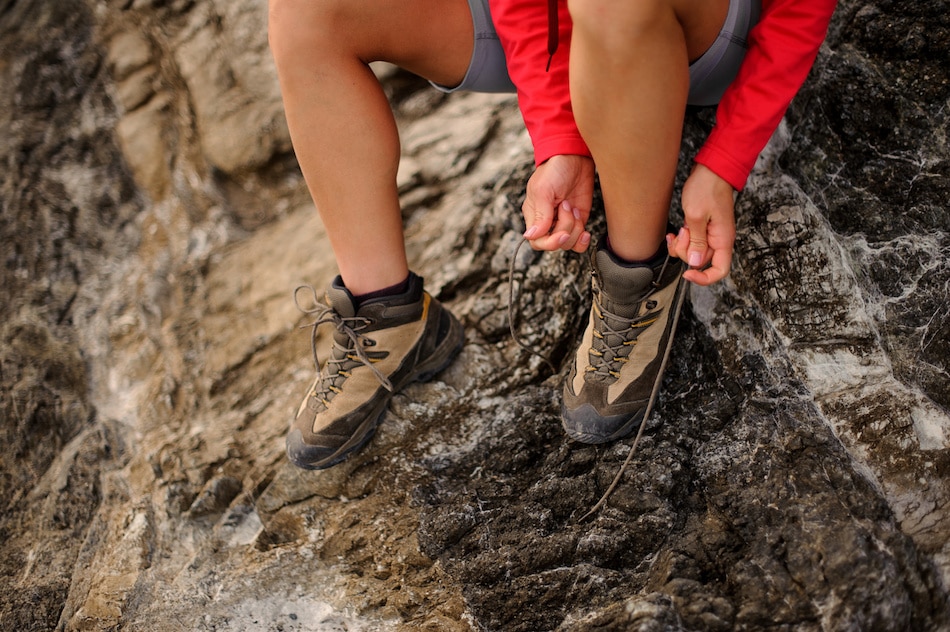What We'll Cover
How Do You Choose the Best Hiking Boots For Your Needs?
Outdoor adventures can be a blast, but poor footwear can ultimately make experiencing even the most beautiful scenery a real bummer. Great food, even cooked in the best camping pots, can’t help your outlook if your feet hurt.
Finding shoes for our regular activities is often very difficult. Many people have to have comfortable shoes to walk in or work in. Strong work boots may not be appropriate for hiking! And certainly, dress shoes or high heels won’t work in the rugged outdoors.
Even experienced hikers have likely found themselves submitting to blisters or tired feet because of choosing the wrong hiking boots. Let’s keep hiking fun and comfortable—take a peek at these tips for choosing the best hiking boots.
The Best Hiking Boots are Determined By Your Adventure
The first tip in our hiking boot buying guide is to determine the location, purpose, intent, and difficulty of the hike. And yes, of course, the season in which your are camping. Yes, hikers may need to consider (and should) buying more than one pair of hiking boots for various types of terrain and distances.
Groomed Trail Hiking. Hikes on well-kept trails in moderate temperatures can be made with just about any type of boot with a low or mid-cut style with breathability. In cooler weather, hikers should employ a good pair of waterproof socks. Groomed trails often lead to or begin at organized caps sites. Great places to chow down before that long hike!
Rough Trail Hiking. Aggressive hikers will want to invest in ankle-high hiking boots that provide adequate protection against sprained ankles in case of a topple or slip. Well-ventilated shoes in warm weather is preferable, while cooler weather trekkers may consider a leather/fabric combination with waterproof liners.
Off-Trail and Extreme Hiking. Those who love going to extremes on long hikes in swampy, rocky, snowy or desert terrain have other considerations when choosing the best durable hiking boots. Many experts advise going for above ankle support boots. Those with crafted with full-grain leather and pronounced lugs on the outsole for better traction and protection. These rigid types of boots can take time to break in, so don’t make that first hike without a few trail runs first.
Four Features to Look for When Choosing the Best Hiking Boots
Choosing the wrong shoes—hiking boots or any other—can cause a myriad of issues such as foot-related hip and knee pain, not to mention how tired those feet can get and how improper hiking boot lacing can affect your feet! Keep these considerations in mind to ensure that your body and your journey is as stress and pain-free as possible.
- Shoe Weight—Experienced hikers may have heard the adage, “A pound on the foot is five on the back.” For less intense hikes, go ahead and use the lightest hiking boot you can get away with to save leg and back stress.
- Arch Support—The feet need to flatten out a bit under the pressure of hikes. This is true especially on inclined surfaces, so support is a must. Those with high arches should think about getting orthotic insoles or inserts.
- Supporting the Load—Those with backpacks of substantial weight need extra sturdiness and flexibility in their vegan hiking boots. Twisted ankles and stubbed toes can easily happen with heavy loads, so consider ankle- or higher-cuffed boots with ample room.
- Consider Waterproof Hiking Boots—The unpredictability of hiking journeys can often leave one facing water challenges. Challenges that may be due to rain or an unexpected creek along the way. Consider waterproof materials for boots. Or use GoreTex socks to protect your feet from potential foot fungus or blisters. This also helps to keep boots free of odors.
Before taking that next hiking excursion, take a good look at your boots. Consider talking to a local outdoor expert who can advise you about any concerns or answer additional questions. And be sure and be well rested, well fed and safe during those hikes.
The responses below are not provided, commissioned, reviewed, approved, or otherwise endorsed by any financial entity or advertiser. It is not the advertiser’s responsibility to ensure all posts and/or questions are answered.


![Tips to Go Camping With a Toddler [Different Weather]](/assets/images/375a17532f44c72a41d33b1008823cf3.png)


